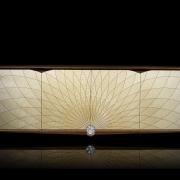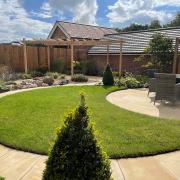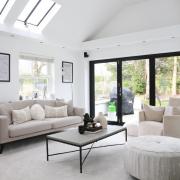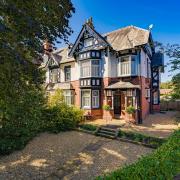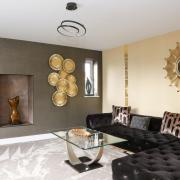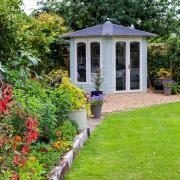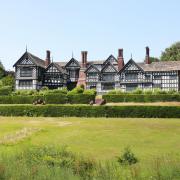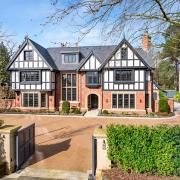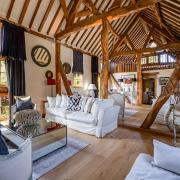When biochemistry isn’t your thing, what do you turn to? For Manchester’s Andrew Kilgour, it took some time to figure that out, and now he’s making something that will forever stand the test of time, the Argentum Luna, a wholly British-made, wholly beautiful, clock.
“I graduated from Manchester University with a degree in biochemistry,” Andrew, who is still resident in Manchester, says, "but knew even while studying I didn’t want a career in the subject. Instead, I joined a graduate management training scheme with Enterprise Car Club, where I learned how to run a business, and then went travelling. One of the friends I travelled with in Australia wanted to start his own business, so we looked into a few ideas and then the opportunity to buy a pub came up. It wasn’t on our list of things to do, but decided to go for it and ten years later had a very successful family pub and restaurant. By this point I was starting a family, and those two lives don’t really work very well – it was difficult having a young baby at home and working those long hours, so it decided it was time for a change.”

Andrew’s business partner bought him out, and Andrew set about thinking about what he might do next.
“It took me a while, and people ask me where the idea came from and I’m not 100 per cent sure, but I knew I wanted to make a product, something high end and low volume. It was a gradual thing; I wanted to focus on a product that would be very high quality and sit comfortably withing the luxury market. I realised there weren’t any really contemporary, high quality wall clocks available. I know that sounds a bit random, but the best way I can explain it is that I love Swiss watches, I love the idea of how they work, that people collect them and there’s a fascination with them, and that you buy not just for yourself but for the next generation, and it grew from there. I researched the market and any really high quality pieces were really quite old fashioned in style, even modern ones being made were based on antique clocks and they didn’t suit the contemporary house – the homes being built now.
“That started me on my journey to make the very best clock I possibly could.”

This journey of discovery took Andrew around the UK, searching out the very best artisan designers and makers to help him achieve his aim, bringing English clockmaking into the contemporary era.
“I was adamant my clock had to be made in England,” he says. “I first hired a product designer to help me realise my design, and then it was up to me to find the people to make it happen, people not only with the necessary skills, but with the right mindset, too.
“I found Sinclair Harding, a renowned clockmaker in Yorkshire. They make traditional looking clocks but do work for other people, and were really receptive to my idea and sent me off with lots of things to think about and questions to answer. It took some time, but we did get to a point where they said they could make the movement for it.”
You might wonder why this was so complicated an ask, as surely if they made movements for clocks already, why would Andrew’s be such a challenge.

“The movement is a ‘great wheel’ movement, this is a traditional movement, but it had to be adapted for the large, heavy hands, which are made from platinum plated brass, as is the movement itself. You can see with traditional clocks that sit on a table, the dial and hands are very small, so the big problem here was that this has big heavy hands circling a big face. You have to have a movement that can drive the hands up the left hand side, and then fight gravity as they want to drop down the right hand side. You have to get it perfectly balanced so it doesn’t lose or gain time with every progress round the dial. Because it hadn’t been done to this size before, it was a lot of work to figure it out – which is why it took five years. When I started out I had wondered why there wasn’t a contemporary, luxury wall clock – and now I know.”
Once this aspect was being worked out, Andrew had to set about finding craftspeople to make the actual clock face, the bit everybody sees first.
“I then had to find a jeweller to make the numerals, which took me to Birmingham’s jewellery quarter, where I found Thomas Fattorini, which was founded in 1826 and has been responsible for some very famous and well-known pieces over its history, including making the original FA Cup. I worked with them to design the numerals, which are each hand-made from solid silver and individually hallmarked.”
Next, the clock face and a step into the automotive industry.

“I went to many companies with my design and eventually found Arrk, in Nuneaton. They make highly engineered parts for cars. The dial is a very complex design. It’s actually a three-dimensional piece and when you’re working with something that size, it’s a very industrial process, even if the finished piece is wholly luxurious. They have to cut a piece of metal, but then they have to finish it, and this is where the risk is very high – the radiating lines on the dial are cut into the dial, and then it needs to be highly polished, which of course risks losing the definition of those rays, but it needs to be very highly polished before the paint is applied, to ensure the finish. Then many, many layers of paint are applied to achieve the pearlescence I wanted, that shimmering texture that just glows and gave rise to the name – Argentum Luna, or Silver Moon.”
The final piece in Andrew’s luxury puzzle is the hand-made, custom-designed case.
“Fattorini put me in touch with a cabinet maker in the Lake District, who they worked with in collaboration for the presentation boxes of some very expensive whiskeys for which they were making the silver labels. He makes the cases, to order, to house the clock when not mounted on a wall.”
The whole process took Andrew five years, but the end result is breathtakingly beautiful and without doubt classifies as an heirloom of the future.
“It’s taken five years to bring this to fruition,” he says, “and I shall only be having twelve made, and each one will be made to order. This means that the customer can make changes, if they choose. Now I have undertaken this project, and found this amazing team of artisans, I can create a whole new piece, working with the end-buyer or an interior designer; a complete one-off, unique clock.”

Argentum Luna could be viewed as a clock, of course, but this seems too functional a term. It’s art, in reality, a glorious creation tapping into England’s world leading design and engineering heritage: an heirloom to be treasured and passed down through generations to come.
“The movement is made in Yorkshire, the silver in Birmingham, the face in Nuneaton and the case in the Lake District. The only element not made here is the glass, which is made in Italy at another heritage creator. It sits completely flush to the front, so it’s sent to Peter in the Lakes, to builds a walnut surround about the glass, then all the components go back to Sinclair Harding in Yorkshire, to assemble the clock. It then sits on a computer for two weeks, which makes sure it keeps perfect time, or no worse than losing one second every month.”
If you’re wondering how to wind it up, it works just like a wristwatch – there's a small door in the base of the clock, which when opened allows a small ‘crown’ to drop down, which is used to both wind the mechanism and adjust the hands, when the clocks change in spring and autumn.
“It will need winding every eight days,” Andrew says. “And, of course, it has a lifetime warranty – not for the life of the owner, but the life of the clock, as it’s a piece to pass to future generations.
“It’s been a good journey to get to this point. I found an amazing team and we have created something truly beautiful – and named it after my two eldest sons, Thomas and James. I can’t wait to start designing the next one.”
Perhaps he’ll name it for his third son, Harry, who arrived recently, and surely needs an heirloom piece of his own to give his name to?





